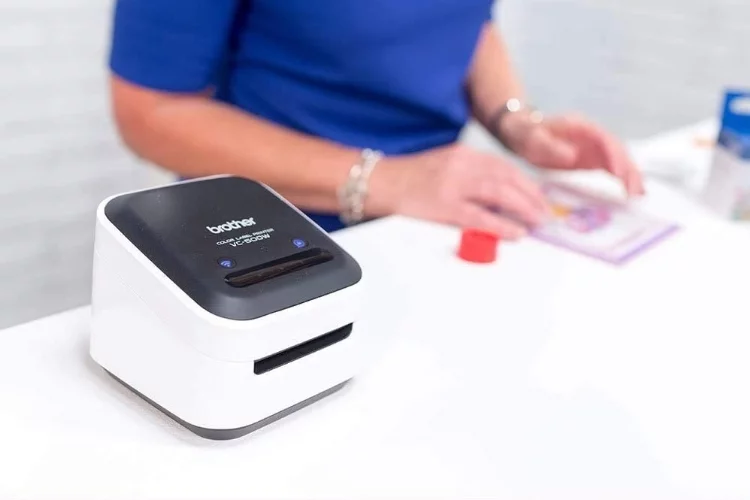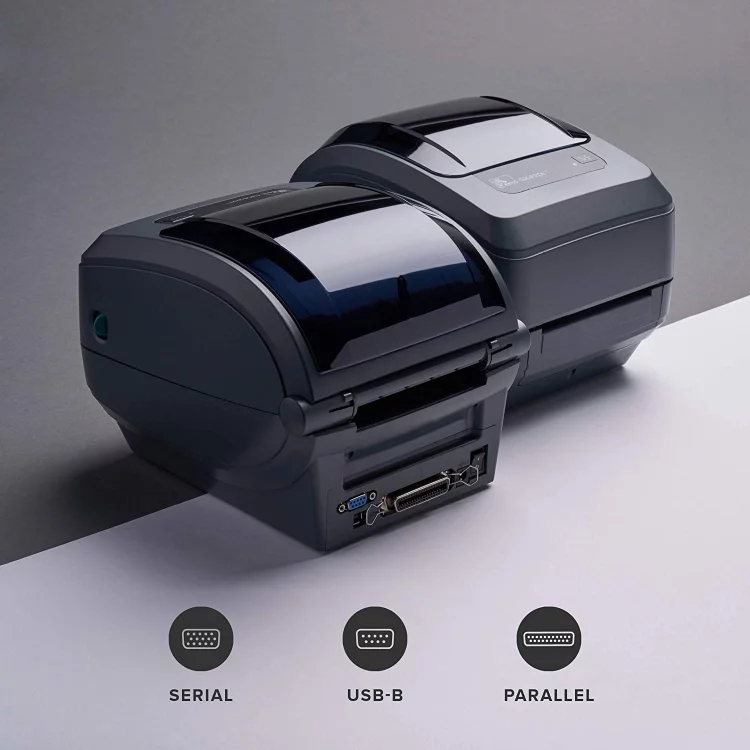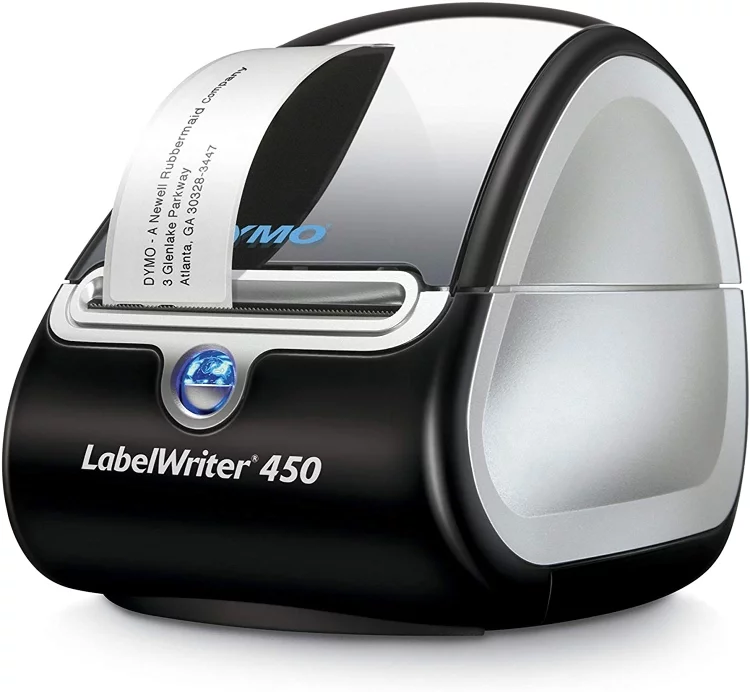Types of Label Printers You Should Know
by Chris & Marry
Did you know that there are different types of label printers? In this blog post, we will be discussing the different types of label printers and what each one is best for. We'll also provide a few tips on how to choose the right type of printer for your needs. So, whether you're looking for a small home printer or a large industrial printer, read on to learn more!
Contents

Thermal Transfer Printer as a Label Printer

What is a Thermal Transfer Printer ?
A thermal transfer printer is a type of label printer that uses heat to transfer ink onto labels. This type of printer is often used for printing barcodes and other types of labels. Thermal transfer printers typically use a ribbon that is coated with a wax or resin-based ink. The heat from the print head melts the ink on the ribbon and transfers it onto the label. Thermal transfer printers can produce high-quality prints, but they are typically more expensive than other types of label printers.
Thermal transfer printers are often used in industrial settings where barcodes need to be printed on labels. These printers are also commonly used for printing shipping labels and other types of labels that need to withstand high temperatures or harsh conditions. Thermal transfer printers typically have a higher print quality than other types of label printers, making them ideal for printing labels that will be visible from a distance.
Pros and Cons of Using a Thermal Transfer Printer as a Label Printer
There are several advantages and disadvantages to using a thermal transfer printer as a label printer.
Pros
Some of the pros include:
- Thermal transfer printers can produce high-quality labels.
- Thermal transfer printers are fast and efficient.
- Thermal transfer printers are relatively inexpensive.
Cons
Some of the cons of using a thermal transfer printer as a label printer include:
- Thermal transfer printers require special paper or labels.
- Thermal transfer printers can be difficult to use.
- Thermal transfer printers can be messy.
If you are considering using a thermal transfer printer as a label printer, weigh the pros and cons carefully to decide if this type of printer is right for you.
Direct Thermal Printer as a Label Printer

What is a Direct Thermal Printer ?
A direct thermal printer uses heat instead of ink to print images and text on paper. This type of printer is often used for printing labels, receipts, and other types of documents that do not need to be permanent. Direct thermal printers are generally less expensive than other types of printers, but they do have some disadvantages. For example, direct thermal printers can only print on one side of the paper, and they tend to fade over time.
If you need to print labels or other documents that will be exposed to light or heat, a direct thermal printer may not be the best option. However, if you need a printer that is less expensive and can print quickly, a direct thermal printer may be a good choice.
Pros and Cons of Using a Direct Thermal Printer as a Label Printer
There are several pros and cons to using a direct thermal printer as your label printer. Here are some of the key points to consider:
Pros
- Direct thermal printers are much cheaper than other types of label printers on the market.
- They are very easy to use and maintain, which makes them ideal for small businesses or home offices.
- Direct thermal printers produce high-quality labels that are resistant to smudging or fading.
Cons
- Direct thermal printers do not have the same range of features as more expensive label printers. For example, they cannot print in color or create barcodes.
- The labels produced by direct thermal printers can be less durable than those produced by other types of label printers.
- Direct thermal printers can be slower than other types of label printers.
Overall, direct thermal printers have both pros and cons that you should consider before deciding if they are the right type of label printer for your needs. If you need a durable, high-quality label printer that can print in color and create barcodes, then you will probably want to choose a different type of label printer. However, if you are looking for an affordable, easy-to-use label printer for your small business or home office, then a direct thermal printer may be the perfect choice for you.
Wax Ribbon Printer as a Label Printer
What is a Wax Ribbon Printer ?
Wax ribbon printers work by heating the wax ribbon and then transferring the melted wax onto the media. The wax then cools and hardens, creating a durable and long-lasting image. Wax ribbon printers are available in a variety of sizes and configurations to meet the needs of any business.
Wax ribbon printers offer a number of advantages over other types of printers. Wax ribbon printers are more durable and can withstand higher temperatures than other types of printers. Wax ribbon printers also produce sharper images and can print on a variety of different media types.
Pros and Cons of Using a Wax Ribbon Printer as a Label Printer
If you are in the market for a label printer, you may be wondering if a wax ribbon printer is the right option for you. Here, we will take a look at the pros and cons of using a wax ribbon printer as a label printer to help you make your decision.
Pros:
- Wax ribbon printers are typically very affordable, making them a great option for those on a budget.
- Wax ribbon printers are generally quite easy to use, which makes them perfect for those who are new to label printing.
- Wax ribbon printers produce crisp, clear labels that are sure to stand out.
Cons:
- Wax ribbon printers can be slower than other types of label printers, so if you need your labels in a hurry, this may not be the best option for you.
- Wax ribbon printers can sometimes have trouble with printing on certain types of materials, so it is important to test out your printer on a variety of surfaces before committing to using it for your label needs.
Overall, wax ribbon printers are a great option for those who are looking for an affordable and easy-to-use label printer. However, there are some things to keep in mind before making your purchase, such as the speed of the printer and its ability to print on different types of materials. Test out your printer on a variety of surfaces before making your final decision to ensure that it will meet your label printing needs.
Thermal Wax Printer as a Label Printer
What is a Thermal Wax Printer ?
A thermal wax printer is a type of computer printer that uses heat to transfer wax-based ink onto paper. Thermal wax printers are often used for printing labels, receipts, and other types of documents that need to be resistant to smudging or fading. Thermal wax printers work by heating up a ribbon of wax-coated paper and then pressing it against the paper that needs to be printed on. The heat from the ribbon melts the wax, which is then transferred onto the paper. The print head of a thermal wax printer is usually made up of an array of tiny heated pins that can create very precise images.
Thermal wax printers are generally more expensive than other types of printers, but they offer a number of benefits. Thermal wax printers are very fast, and they can produce high-quality prints that are resistant to smudging and fading. In addition, thermal wax printers do not require the use of special inks or toners, which makes them more cost-effective in the long run.
Pros and Cons of Using a Thermal Wax Printer as a Label Printer
A thermal wax printer can be a great option for those needing to print both labels and tags. Here are some of the pros and cons of using a thermal wax printer as your label printer:
Pros
- Can print on a variety of materials
- Excellent print quality
- Very fast printing speeds
- Relatively low cost of ownership
- Easy to use and maintain
- Takes up less space than other types of label printers
- Long lasting prints - can last for years with proper care
- Prints are resistant to smudging and fading
- Can be used with a variety of software programs
- Perfect for those who need to print both labels and tags!
Cons
- Limited color options
- Materials can be expensive
- Not as versatile as some other types of label printers
- prints can be difficult to remove from certain surfaces
- Some software programs may not be compatible with a thermal wax printer
Dye-Sublimation Printer as a Label Printer
What is Dye-Sublimation Printer ?
The Dye-Sublimation Printer is a digital printing technology that uses heat to transfer dye onto materials such as fabric, paper, or plastic. The process is similar to screen printing, but the results are more accurate and consistent. Dye-sublimation printers are commonly used for creating custom t-shirts, banners, and other personalized items.
Dye-sublimation printers use a four-color printing process (cyan, magenta, yellow, and black) to produce full-color images. The inks are transferred onto a substrate, such as fabric or paper, using heat and pressure. The high temperatures cause the dye molecules to vaporize and attach themselves to the material. As the material cools, the dye molecules solidify and create a permanent image.
Dye-sublimation printing is ideal for creating high-quality, full-color images on a variety of materials. The technology is frequently used for creating custom t-shirts, banners, flags, and other personalized items. Dye-sublimation printers are available in a variety of sizes and price points, making them a good option for both home and small businesses.
Pros and Cons of Using a Dye-Sublimation Printer as a Label Printer
Pros
As with any type of printer, there are both pros and cons to using a dye-sublimation printer for labels. Some of the benefits of using this type of printer include:
- Dye-sublimation printers produce very high-quality prints.
- The colors produced by dye-sublimation printers are very rich and vibrant.
- Dye-sublimation printers are very fast, making them ideal for high-volume printing projects.
- These printers are very versatile and can be used to print on a variety of different materials, including paper, plastic, fabric, and even metal.
- Dye-sublimation printers are relatively affordable, making them a good option for businesses on a budget.
Cons
However, there are also some drawbacks to using dye-sublimation printers, which include:
- Dye-sublimation printers require special inks, which can be costly.
- These printers can be difficult to operate, and they require regular maintenance.
- Dye-sublimation printers can produce prints that are prone to smudging and fading over time.
- Some materials, such as dark-colored plastics, can be difficult to print on using a dye-sublimation printer.
Overall, the pros and cons of using a dye-sublimation printer need to be weighed carefully before deciding whether or not this type of printer is the right option for your business. If you are looking for a high-quality, fast, and versatile printer, then a dye-sublimation printer may be a good choice. However, if you are on a tight budget or if you are not willing to invest in special inks and maintenance, then another type of printer may be a better option.
Laser Label Printer as a Label Printer
What is a Laser Label Printer ?
A laser label printer is a special type of printer that uses a laser beam to print labels. This type of printer is usually used for printing barcodes, but can also be used to print other types of labels. Laser label printers are faster than traditional printers and can print labels at a higher quality.
Laser label printers work by using a laser beam to draw the desired label onto the label material. The laser beam is directed through a mirror system and focused onto the label material. The label material is then heated by the laser beam and the label is printed.
Laser label printers are available in both desktop and industrial models. Desktop laser label printers are smaller and less expensive than industrial models, but they do not have the same printing speed or quality. Industrial laser label printers are larger and more expensive, but they can print labels at a much higher quality and speed.
Laser label printers can be used to print labels for a variety of purposes. They are commonly used to print barcodes, but can also be used to print labels for product identification, address labels, and even postage stamps.
Laser label printers are an important part of any business that needs to print labels. If you are looking for a printer that can provide high quality labels at a fast pace, then a laser label printer may be the right choice for you.
Pros and Cons of Using a Laser Label Printer as a Label Printer
There are a few things you should consider before purchasing a laser label printer for your business. Here are some pros and cons to help you make your decision:
Pros
- Laser label printers produce high-quality labels.
- They are relatively fast, printing up to 30 labels per minute.
- Laser label printers can print on a variety of materials, including paper, cardboard, and even fabric.
- You can find laser label printers that fit your budget.
Cons
- Laser label printers require special toner cartridges, which can be expensive.
- They can be difficult to operate if you're not familiar with them.
- You may need to purchase special software to use with your laser label printer.
Overall, laser label printers have more pros than cons. If you're looking for a high-quality label printer that can print on a variety of materials, a laser label printer is a good choice. However, if you're on a budget, you may want to consider another type of label printer.
Conclusion on Most Common Types of Label Printers
As you can see, there are a variety of label printers on the market today. Each type has its own advantages and disadvantages, so it's important to choose the right one for your needs. If you're looking for a high-quality label printer that can handle a variety of materials, the thermal transfer printer is an excellent choice. However, if you need a more affordable option, the inkjet label printer may be a better bet. Whichever type of label printer you choose, make sure to do your research to ensure you're getting the best possible value for your money.
Thermal transfer printers are the best choice for those who need high-quality labels that can withstand a variety of environmental conditions. However, they are more expensive than inkjet label printers. If you're on a budget, inkjet label printers may be a better option for you. Whichever type of label printer you choose, make sure to do your research to ensure you're getting the best possible value for your money.
 |
 |
 |
 |

About Chris & Marry
Chris and Mary fell in love with printmaking in college, and they've been exploring the art form ever since. They are experts in the field, and have written extensively about printer troubleshooting and printmaking. These days, they love to write about their experiences with printmaking and share tips with other artists. They are always learning new things about the art form, and they can't wait to see what the future holds for them as printmakers.
Thoughts on "Types of Label Printers You Should Know"
 |
 |
 |
 |
Recent Post
Time to get FREE Gifts. Or latest Free printers here.
Disable Ad block to reveal all the info. Once done, hit a button below
 |
 |
 |
 |